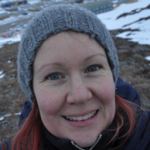Nunavik high school students missing credits needed to move into higher education: research
“We’re trying to understand what kind of curriculum we have and what we can improve on”
Kativik Ilisarniliriniq’s council of commissioners listen to a presentation by Sherbrooke University sociologist Sylvain Bourdon, who is reviewing the school board’s curriculum and learning outcomes. (Photo by Malaya Qaunirq Chapman)
A review of Nunavik’s school curriculum has found that secondary students are missing key courses needed to get into certain post-secondary programs.
Ongoing research into Kativik Ilisarniliriniq’s curriculum and learning outcomes is headed by Sherbrooke University sociologist Sylvain Bourdon, who presented some early findings to the school board’s council of commissioners in Kuujjuaq Dec. 9.
So far, the research suggests that Nunavik’s schools aren’t equipped to teach many secondary-level science and math classes required to apply to certain Cegep – the Quebec equivelant to community college – or university-level programs.
“When we reach secondary studies, that’s where we see that we’re falling behind,” Kativik Ilisarniliriniq’s director general, Harriet Keleutak, told commissioners last week.
“It goes to show that in science and math, our students are missing prerequisites to pursue careers in higher education. They have to take extra courses when they get down to Montreal.”
There is no environmental science and technology option in Kativik Ilisarniliriniq schools, for example, though a new environmental science program is being developed.
Students wanting to take health sciences or natural sciences must complete Secondary 5 (the equivelant to Grade 11) chemistry and physics courses elsewhere before entering a post-secondary program.
And in English as a second language, the research found that the required competency level at the end of secondary is below what’s needed for post-secondary education in English.
In terms of Inuktitut-language curriculum in Nunavik’s schools, Keleutak said there is plenty of material, but not enough Inuit instructors to teach it.
Kativik Ilisarniliriniq has no equivalent to Quebec’s broad, formal curriculum — the purpose of the review is to help the school board standardize its programs.
“With the research, we’re trying to understand what kind of curriculum we have and what we can improve on,” Keleutak told Nunatsiaq News.
“They’re trying to understand if we’re lacking compared to second-language learners elsewhere in Quebec.”
Kativik Ilisarniliriniq is unique in Quebec in that its schools teach Inuktitut until Grade 3, at which point students choose a second language: English or French.
“When they go into Grade 4, it’s like they’re starting kindergarten in many ways,” Keleutak said.
Though students and educators have long known about Nunavik’s barriers to higher education, Keleutak said this is the first time the school board has been able to flag and document those gaps.
Researchers are expected to wrap up their work and present their complete findings in mid-2022.
As part of the school board’s review, officials with the board are asking Nunavimmiut to fill out a questionnaire on bilingual education, to weigh in on how Kativik Ilisarniliriniq teaches Inuktitut, English and French.
You can fill out the questionnaire on the school board’s website.







For the pass 40 years there’s have been a competition between the need for Inuktitut language and an education. The two has been in competition with each other. It’s been to keep our language, but lose out on education. The Inuktitut language has been kept out of the education process. No teachers educated enough to teach it. The leaders of KI always pushed the language first, but as we been seeing, education suffers. It’s kind of a unique situation, because usually language goes with education, but not Inuktitut. It’s because of the lack of education. Funny that language keeps people from getting an education, but that’s what we are seeing in Nunavik. Kids taking the language in the first three grades, but starting off as kindergarten in education in grade 4 , speaks it somewhat. But it’s even more than that. The language in the earlier grades has also implemented an opposition to education throughout the school life of the students, putting a mind set of its Inuktitut or its education, you choose. It’s the leaders of KI who are responsible for the last 40 years of Inuit not getting an education. If they were to leave language alone and let be, Inuktitut and education would be married well today, 40 years later.
Fake!! All fake diplomas. Sue KI not for $, but to admit they deceived the population, get them to apologize and improve their hiring process, hire better teachers who have better experience who are not fresh out of school and wont go on mental leave collecting pay while walking around and enjoying our great views…. Sue the Que Ministry for $, for our salaries lost and $ to pay for better teachers.
You can earn a Diploma that does not qualify you to go to College or University. Every High School in Canada offers that option, as not every student wants to go, or for that matter, is capable of going to College or Cegep. As well, not every student is capable of passing the high school courses this article discusses.
This is no secret and KI isn’t keeping it a secret. But some people really don’t pay attention, and prefer to complain after the fact.
It’s even in the article:”Though students and educators have long known about Nunavik’s barriers to higher education, Keleutak said this is the first time the school board has been able to flag and document those gaps.”
They kept it a secret before the truth came out. They knew that what was given to the graduates where equal to that of attestations and not diplomas. I dare anyone out there to get a legal firm to review the ombudsman report. Try the ones handling the ex-inmates class action lawsuit.
I am scared to do it myself. I am not all that smart. I grew up in KSB edu-ma-cation.
Kativik’s problems with curriculum are nothing new, have been in the news for years and are far from a secret.
https://nunatsiaq.com/stories/article/65674nunavik_high_school_students_havent_received_diplomas_since_2013/
I think they need a course on how to calculate 2 metres. Is it a smaller distance if you learn it in Inuktitut?
Or is social distancing no longer required in Nunavik?
I teach Nunavik students in two post-secondary programs.
Most of the Nunavik students I see today are usually at a southern elementary school level — they would be weak students in an ordinary southern high school.
It’s not just their English level. It’s their understanding of what it takes to be a successful school student. It’s their intellectual development and their work ethic which is sorely lacking.
The students are paying the price, therefore Nunavik is paying the price. Just think about the students that are capable of doing well sitting in class with the majority that are not. Many students in Nunavik are not well supported in their studies from home. They don’t have the support of parents and or care givers. Not only are they missing out on school days due to teachers calling in sick , but many students don’t go to school due to lack of interest in the first place. I don’t understand why more organizations are not speaking out on this issue. There we have Makivik in its infancy plan for self government, and no educated people to fill the roles. The whole of Nunavik society can’t grow and develop with its current state of affairs. The recipe for success is not there. This student issue is only the tip of the ice berg. There’s no incentive to succeed in too many aspects. The school ethics is missing, the work ethic is missing. Too many people are doing the wrong things. Too many people are not getting up in the morning to participate in activities that makes for a healthy life. You see business ran by local people closed, but as soon as beer and wine sales start, everyone seems to be rushing to buy. It’s very screwed up.
As mentionned above, it is way more than a curriculum issue. Being physically present at school, is the primary predictor of success. This also suppose the capacity of being intellectually present. Many things can be made to make school a safe place so student’s mind can open to new learning. And schools can only do so much within its arm’s lenghts. Parents and community holds a big part in making what needs to be done to create a safe place for kids. I see just too many ACE (Adverse Childhood Events – See https://www.joiningforcesforchildren.org/what-are-aces/ ) occuring in Nunavik. Such adverse events occuring in the community and within family setting creates a state where the child’s mind works in protection mode. This mode is impeeding a normal learning process. Above restricting that capacity to learn and obtain adequate education for the purpose of owning a good life, ACE are creating a lot of health problem amongst other we find addiction, suicide, heart disease, diabete and so many more . ACE issues can only be handled by the communities and families with the support of institution. Who is going to rise and say present ?
Anyone who thinks learning Inuktitut stunts a child’s learning should not be working in Nunavik education. Inuktitut language is a whole world of knowledge and the students will become fulfilled having learned all that comes with it. The only thing starting in grade 4 is a new language, not intelligence or competence. Give our kids a reason to go to school and stop talking about their language like it’s a problem.
Inuktitut is very important as language is very important. I don’t see anyone talking negatively about Inuktitut, it’s just that there are only one or two educated Inuit or Inuktitut speaking reachers to teach. Since that’s the case, the first three years of learning Inuktitut is not really a learning teaching experience for the young student. It’s therefore in opposition to the proper methods of teaching , and the students waste three years. What they learn in theses three years is not really from the teaching, but it’s from community and family and peers
Why is Inuktitut only taught in the first three years , and not taught all through the school years for the student. I mean why isn’t it a first or second language choice , like English and French, be honest now with your answer. I particularly like an answer from those KI leaders running the program for eons.
My M.Ed was in culturally safe schooling for Inuit students in Nunavik, KI has amazing curriculum developers in their board right now- it’s the teachers (Inuit and Non-Inuit) as well as speaking to communities and students directly.
I would also want to analyze how Universities in the south are creating culturally safe learning spaces for Inuit (and all Indigenous) students. We want to ensure students are successful academically, but also know that it was because they are Inuit that they are successful, not despite of their culture.
I hope they don’t “southernize” the Inuit schooling system. That would miss the point.
Hi Jasmin, I wonder if you could help those of us who are unfamiliar with the terminology you are using to understand the meaning of a “culturally safe learning space”? And what your concerns are around a ‘southernized the Inuit schooling system’?
Thanks in advance
Dear Nunatsiaq, would you kindly remove the word ‘the’ from my last sentence? it was a typo. If you don’t want to no worries, I know you have changed my comments in the past, i didn’t even have to ask those times 🙂
All the best
No social distancing and no masks, i think you guys deserve a call from public health